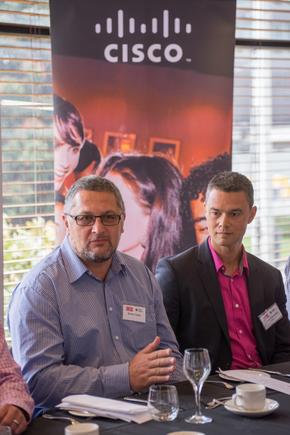CIO roundtable: Conversations on collaboration
- 19 February, 2015 06:00

Panellists
Kris Dunne, head of IT security, architecture and strategy, New Zealand Racing Board
Carmen Casagranda, national IT manager, CIGNA Life Insurance NZ
Richard Parry, chief information officer, Stand Children's Services - Tu Maia Whanau
Alan Clifford, director, Information Systems Audit & Assurance, Audit New Zealand
Clive Eastwood, manager - operations & support, Ministry of Business, Innovation and Employment
John McMullen, head of IT, Weta Workshop
Laureen Jones, IT manager, Te Papa Museum
Simon Taylor, business consultant and former head of Enterprise Delivery, Kiwibank
Matti Seikkula, CIO, e-Spatial
Jonathan Rawiri, ICT consultant and former architecture services manager, Z Energy
Patrick Brennan, infrastructure architect, Opus International Consultants
Richard Ashworth, CIO, Commerce Commission
Stephen Crombie, 2IC strategy and executive director; Information, Technology and Systems, New Zealand Police
Glen Bearman, territory account manager, Cisco New Zealand
Simon Baxter, marketing manager, Spark Digital
Jason Tamasese, collaboration specialist, Cisco New Zealand
Greg Brown, business manager, Government, Spark Digital
In pictures: CIO Roundtable on 'The dynamics of collaboration' (Wellington)
In the past 20 years, the collaboration toolset people use has continued to grow, noted Alan Lepofsky in his report on The State of Collaboration 2015.
Organisations started email and chat, then added blogs and wikis, followed by enterprise social networks, messaging clients, file-sharing services, question and answer sites, ideation tools, task management programs, and many more.
“Each time another tool was added, complexity increased for people trying to do their jobs,” noted Lepofsky, a principal analyst at Constellation Research.
He asked, “Have these tools enabled people to achieve the level of productivity promised by vendor marketing?”
Perhaps, people don’t need more tools, he surmised, but instead need their current tools to do more: Be more efficient, effective, personal, integrated and secure.
So how are New Zealand organisations dealing with the influx of collaboration tools?
At a recent CIO roundtable in Wellington, we asked a panel of ICT executives from across a spectrum of organisations – government, not for profit, enterprise and technology – about their experiences in this space.
The panellists are at different stages of deploying collaboration tools, with users ranging from internal to global customers and partners, and industry organisations.
Common themes emerged: Vetting of which tools to deploy, challenge of user uptake and security are among the top concerns raised by the panellists.
Greg Brown of Spark Digital set the backdrop of the discussion.
“The world is fast becoming a smaller place,” said Brown. “With globalisation and organisational networks extending to external parties like customers and the latter’s customers, new challenges are emerging. And the ecosystem is evolving, as well.

“We are familiar with the technology and tools that comprise collaboration today. The question is what the next phase of collaboration might be, and how can organisations embrace it?”
Leading the way
Simon Taylor said collaboration tools have to be driven from the top, the executive teams.
“They have to drive and demonstrate those behaviours, be seen to be doing the engagement, and drive it back up through the organisation,” said Taylor, who was most recently head of Enterprise Delivery at Kiwibank.

Richard Parry of Stand Children Services, observes the best take up for these tools occurred when a member of the executive team suggested taking a particular discussion to the enterprise social networks, to avoid flooding their inbox with emails that have been copied to various users.

“That was the trigger to use them,” he said.
Patrick Brennan, infrastructure and network architect of Opus International, said the company “builds a campaign" akin to “full-time marketing” around any collaboration tool it rolls out.
“Get them excited about it," he said on pointers to encourage user uptake of the collaboration tools. "Make a big deal with the presentation. We have a lot of internal marketing; we put posters around offices, did mailers on the internal mailing lists to all the users and kept everybody informed."
They also involve people in test groups. “If you put together something that you want to roll out as a collaboration tool, ask some people, 'Would you like to be part of a group that helps test this product as part of your proof concept and pilot?’”
The younger generation also expects these tools to be available to them, stated Brennan. “And when you provide those tools for people in that mind-set, they immediately become more productive, because you've got something that interests them.”
Brennan said the engineering and construction company is rolling out a series of collaboration tools and mobile device management in the next two years.
“It is kind of ground-breaking, greenfields for us, because this is in some respects the first time we’ve done anything like this within the company,” said Brennan.

These tools enable the PIN (practice information network) groups to be more successful, and have more collaboration amongst users across the globe.
He said that with Opus acquiring companies across the globe, the focus is to become “really lean” when it comes to operating costs.
He believes this is one of the reasons why they have been successful in the uptake of these tools. Plus, collaboration tools have helped cut down on costs for travels and meetings, he said.
According to Brennan, collaboration tools also aid the PIN (practice information network) groups that have been formed by local and offshore Opus staff.
An example would be a group of experts on bridges, and they would get together and share information. The networks also encompass interests outside work, such as a group of fly-fishing enthusiasts.
“We have historically always used the Internet for that, but now these tools enable the PIN groups to be more successful, and have more collaboration amongst users across the globe,” said Brennan.
John McMullen of Weta Workshop, said their work requires collaborating not only with clients, but also production staff who are working on film and television projects from potentially anywhere in the world. The company also works with large data sets and is looking for better ways of capturing and sharing the latest information with managers and team leaders.

Thus, collaboration technologies are critical to Weta Workshop’s success.
“We will have someone working on something and then all of a sudden, a client wants to go a different direction, and it's critical that everyone is on the same page so that we don't lose time,” said McMullen. “But we also don't risk missing deadlines, because we have some of the tightest deadlines compared to most industries.”
Smart workplace
Kris Dunne of the NZ Racing Board said the organisation is in the process of deploying collaboration tools as part of laying the foundations for a flexible workplace that will be fit for future demands and the expectations of the next generation of staff.
The NZ Racing Board is moving their systems to the cloud – both local and offshore. As a part of this approach, the NZRB will be adopting Google business apps for productivity and collaboration services.
“We go out for collaboration tools, because it's [about] how we're building a workplace environment fit for tomorrow, not today. Cost effective or benefits are secondary,” explained Dunne.
Dunne noted how technology has eased the way for a more collaborative workplace, with compute and storage, for instance, becoming a commodity item.

“The biggest issues we've seen to the adoption of the collaboration is the barriers we put around how you must work (document and record management tools, for instance), instead of embracing the principle of ‘how they (our people) wish to work’, and working on a solution for that.”
“We're now focusing on how we enable our staff and the people to be able to utilise the services more effectively to engage our customer base,” he said.
The move to Google cloud means staff would have full access 24x7 to systems, no matter where they are, providing major improvements to the organisation’s BCP and remote working capabilities.
Technology is by far the least important factor in looking at collaboration, said Dunne. “Literally the critical aspect to any successful deployment of collaboration toolsets is the culture of your people, having the right people and the right environment, and empowering them to trust each other.
We're here to enable our current workforce, but we have to prepare for the future workforce.
“To the generations of people and talent we're looking to hire, it's highly relevant. It's how they function. It's how they work,” says Dunne. “We're here to enable our current workforce, but we have to prepare for the future workforce.
“And that future workforce does not work in an office eight, nine hours a day. So how do you go from an inflexible arrangement to flexible, collaboration based, full remote access capability, and still maintain a security compliance level?
“If you want to be relevant in a digital age your technology team needs to be on the front foot leading the organisation," said Dunne.
Clive Eastwood of the Ministry of Business, Innovation and Employment, said their move to a brand new building has facilitated the deployment of new collaborative technologies.

“Technical limitations are being removed ,” stated Eastwood. “We've reconfigured the whole building, with wireless and collaboration spaces throughout the area."
“Having the new technology has enabled a completely different mindset and cultural shift.”
"People can, with their devices, get up and walk around and plug it in, not plug it in, sit down, and work anywhere. And so that means they can also do that at home through their own wireless networks.”
Having the new technology has enabled a completely different mindset and cultural shift.
Jason Tamasese said his work at Cisco New Zealand exposes him to the latest and greatest tools and leading edge technologies.
He finds it interesting that the tools people have been using to communicate with friends and family have been better than what is being used in the office.

But this has changed with the advent of new collaboration technologies that have met the demand for usability.
He said for the first time in his life, he has seen the number of email messages go down. “I am still using email, because that has been a common platform, [but] now that collaboration tools like video, instant messaging, web conferencing and social networking have become widely used, there are more efficient and easier ways to get things done."
Interactions
Stephen Crombie of the New Zealand Police said collaboration technologies play a critical role in public safety.
The focus for the Police is how to use a variety of collaboration tools for staff to engage internally, and with other departments and non-government agency partners.

“That's the nature of the business itself,” said Crombie. “And enabling that collaboration is incredibly important. So in an investigation, how do we get the people who are participating in an investigation to collaborate?
“The new tools allow that to happen. We can share information in real time and get intelligence from what's been produced,” he said.
Carmen Casagranda at Cigna Life Insurance works with colleagues in about 30 countries. “There's an appetite to be collaborative; people need it,” she said.
She said Cigna currently uses email as a primary collaboration platform, but it is also looking at new technologies and the security around these and what these can enable staff to do.

“Our information protection is very significant and governs the protocols around what we can and cannot do," she explained. "For example, this constrains our use of cloud technology but we are looking to leverage other technologies for messaging and video communication."
The collaboration mind-set
Matti Seikkula of e-Spatial uses a lot of collaborative tools when they work with their customers and business partners.
Uptake of these tools require a mindshift, as well. Basically, a lot of people are used to writing long-winded emails, but with these (collaboration) tools, people have to put things into little text bits, Seikkula said.

“Rather than creating a big Word document of your findings, you might use other tools and create a Mind Map,” he stated.
He has witnessed how some staff, who were seen as introverts, would adopt a different persona once they start using these tools. “Their floodgates [for collaboration] open and you can't stop them, which is good.”
It has to work the first time…Otherwise, there are no second chances.
Simon Baxter at Spark Digital said having an activity-based work environment allows staff to work with colleagues and external groups wherever they are, as they have access to multiple channels for communication.

A caveat, though, is that users expect “good, powerful, and proper” experiences with using collaboration tools. "It has to work the first time, with no lengthy waiting time,” explained Baxter. “Otherwise, there are no second chances.” Photos by Brooke Wollett






Send news tips and comments to divina_paredes@idg.co.nz
Follow Divina Paredes on Twitter: @divinap
Follow CIO New Zealand on Twitter:@cio_nz
Sign up for CIO newsletters for regular updates on CIO news, views and events.

